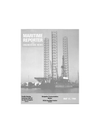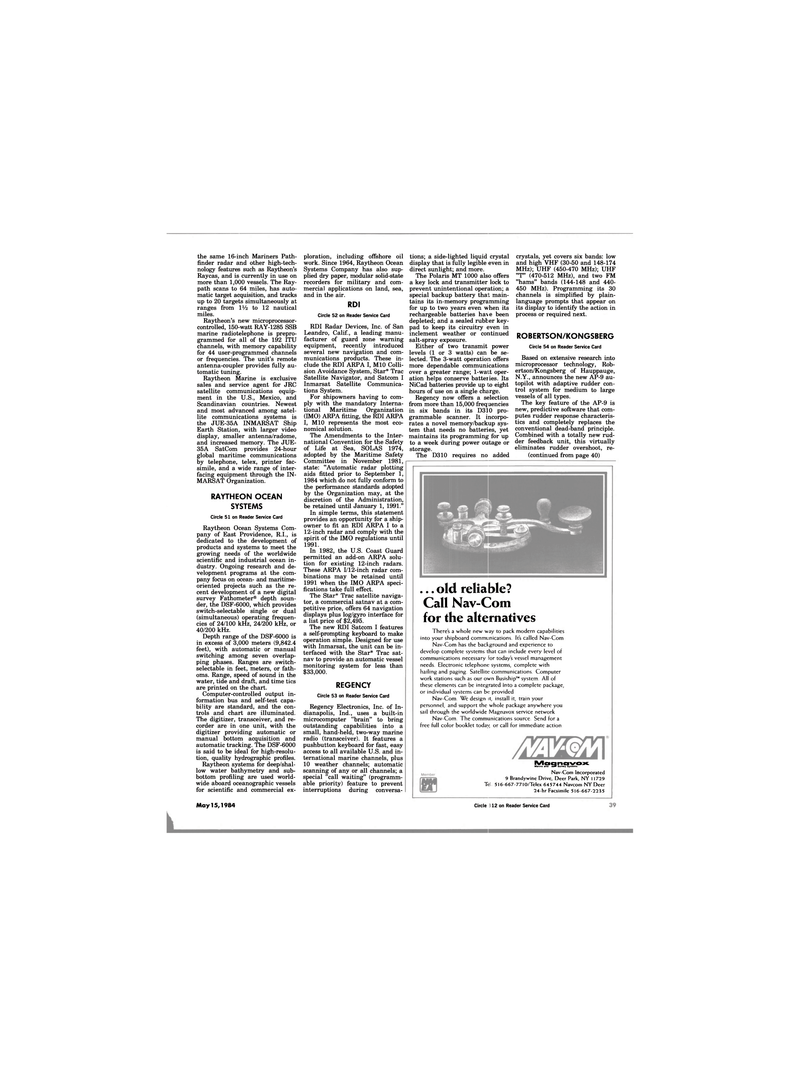
Page 39: of Maritime Reporter Magazine (May 15, 1984)
Read this page in Pdf, Flash or Html5 edition of May 15, 1984 Maritime Reporter Magazine
the same 16-inch Mariners Path- finder radar and other high-tech- nology features such as Raytheon's
Raycas, and is currently in use on more than 1,000 vessels. The Ray- path scans to 64 miles, has auto- matic target acquisition, and tracks up to 20 targets simultaneously at ranges from IV2 to 12 nautical miles.
Raytheon's new microprocessor- controlled, 150-watt RAY-1285 SSB marine radiotelephone is prepro- grammed for all of the 192 ITU channels, with memory capability for 44 user-programmed channels or frequencies. The unit's remote antenna-coupler provides fully au- tomatic tuning.
Raytheon Marine is exclusive sales and service agent for JRC satellite communications equip- ment in the U.S., Mexico, and
Scandinavian countries. Newest and most advanced among satel- lite communications systems is the JUE-35A INMARSAT Ship
Earth Station, with larger video display, smaller antenna/radome, and increased memory. The JUE- 35A SatCom provides 24-hour global maritime communications by telephone, telex, printer fac- simile, and a wide range of inter- facing equipment through the IN-
MARSAT Organization.
RAYTHEON OCEAN
SYSTEMS
Circle 51 on Reader Service Card
Raytheon Ocean Systems Com- pany of East Providence, R.I., is dedicated to the development of products and systems to meet the growing needs of the worldwide scientific and industrial ocean in- dustry. Ongoing research and de- velopment programs at the com- pany focus on ocean- and maritime- oriented projects such as the re- cent development of a new digital survey Fathometer® depth soun- der, the DSF-6000, which provides switch-selectable single or dual (simultaneous) operating frequen- cies of 24/100 kHz, 24/200 kHz, or 40/200 kHz.
Depth range of the DSF-6000 is in excess of 3,000 meters (9,842.4 feet), with automatic or manual switching among seven overlap- ping phases. Ranges are switch- selectable in feet, meters, or fath- oms. Range, speed of sound in the water, tide and draft, and time tics are printed on the chart.
Computer-controlled output in- formation bus and self-test capa- bility are standard, and the con- trols and chart are illuminated.
The digitizer, transceiver, and re- corder are in one unit, with the digitizer providing automatic or manual bottom acquisition and automatic tracking. The DSF-6000 is said to be ideal for high-resolu- tion, quality hydrographic profiles.
Raytheon systems for deep/shal- low water bathymetry and sub- bottom profiling are used world- wide aboard oceanographic vessels for scientific and commercial ex- ploration, including offshore oil work. Since 1964, Raytheon Ocean
Systems Company has also sup- plied dry paper, modular solid-state recorders for military and com- mercial applications on land, sea, and in the air.
RDI
Circle 52 on Reader Service Card
RDI Radar Devices, Inc. of San
Leandro, Calif., a leading manu- facturer of guard zone warning equipment, recently introduced several new navigation and com- munications products. These in- clude the RDI ARPA I, M10 Colli- sion Avoidance System, Star* Trac
Satellite Navigator, and Satcom I
Inmarsat Satellite Communica- tions System.
For shipowners having to com- ply with the mandatory Interna- tional Maritime Organization (IMO) ARPA fitting, the RDI ARPA
I, M10 represents the most eco- nomical solution.
The Amendments to the Inter- national Convention for the Safety of Life at Sea, SOLAS 1974, adopted by the Maritime Safety
Committee in November 1981, state: "Automatic radar plotting aids fitted prior to September 1, 1984 which do not fully conform to the performance standards adopted by the Organization may, at the discretion of the Administration, be retained until January 1, 1991."
In simple terms, this statement provides an opportunity for a ship- owner to fit an RDI ARPA I to a 12-inch radar and comply with the spirit of the IMO regulations until 1991.
In 1982, the U.S. Coast Guard permitted an add-on ARPA solu- tion for existing 12-inch radars.
These ARPA I/12-inch radar com- binations may be retained until 1991 when the IMO ARPA speci- fications take full effect.
The Star* Trac satellite naviga- tor, a commercial satnav at a com- petitive price, offers 64 navigation displays plus log/gyro interface for a list price of $2,495.
The new RDI Satcom I features a self-prompting keyboard to make operation simple. Designed for use with Inmarsat, the unit can be in- terfaced with the Star* Trac sat- nav to provide an automatic vessel monitoring system for less than $33,000.
REGENCY
Circle 53 on Reader Service Card
Regency Electronics, Inc. of In- dianapolis, Ind., uses a built-in microcomputer "brain" to bring outstanding capabilities into a small, hand-held, two-way marine radio (transceiver). It features a pushbutton keyboard for fast, easy access to all available U.S. and in- ternational marine channels, plus 10 weather channels; automatic scanning of any or all channels; a special "call waiting" (programm- able priority) feature to prevent interruptions during conversa- tions; a side-lighted liquid crystal display that is fully legible even in direct sunlight; and more.
The Polaris MT 1000 also offers a key lock and transmitter lock to prevent unintentional operation; a special backup battery that main- tains its in-memory programming for up to two years even when its rechargeable batteries have been depleted; and a sealed rubber key- pad to keep its circuitry even in inclement weather or continued salt-spray exposure.
Either of two transmit power levels (1 or 3 watts) can be se- lected. The 3-watt operation offers more dependable communications over a greater range; l-watt oper- ation helps conserve batteries. Its
NiCad batteries provide up to eight hours of use on a single charge.
Regency now offers a selection from more than 15,000 frequencies in six bands in its D310 pro- grammable scanner. It incorpo- rates a novel memory/back up sys- tem that needs no batteries, yet maintains its programming for up to a week during power outage or storage.
The D310 requires no added crystals, yet covers six bands: low and high VHF (30-50 and 148-174
MHz); UHF (450-470 MHz); UHF "T" (470-512 MHz), and two FM "hams" bands (144-148 and 440- 450 MHz). Programming its 30 channels is simplified by plain- language prompts that appear on its display to identify the action in process or required next.
ROBERTSON/KONGSBERG
Circle 54 on Reader Service Card
Based on extensive research into microprocessor technology, Rob- ertson/Kongsberg of Hauppauge,
N.Y., announces the new AP-9 au- topilot with adaptive rudder con- trol system for medium to large vessels of all types.
The key feature of the AP-9 is new, predictive software that com- putes rudder response characteris- tics and completely replaces the conventional dead-band principle.
Combined with a totally new rud- der feedback unit, this virtually eliminates rudder overshoot, re- (continued from page 40)
Tel
Maqnavox
Marine and Survey Systems
Nav-Com Incorporated 9 Brandywine Drive, Deer Park, NY 11729 516-66 7-7710/Telex 645744 Navcom NY Deer 24-hr Facsimile 516-667-2235 ... old reliable?
Call Nav-Com for the alternatives
There's a whole new way to pack modern capabilities into your shipboard communications. It's called Nav-Com
Nav-Com has the background and experience to develop complete systems that can include every level of communications necessary for today's vessel management needs Electronic telephone systems, complete with hailing and paging Satellite communications Computer work stations such as our own Busiship™ system All of these elements can be integrated into a complete package, or individual systems can be provided
Nav-Com We design it, install it, train your personnel, and support the whole package anywhere you sail through the worldwide Magnavox service network
Nav-Com The communications source Send for a free full color booklet today, or call for immediate action
May 15,1984 Circle 112 on Reader Service Card 41

 38
38

 40
40
